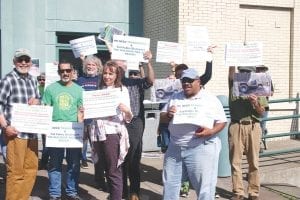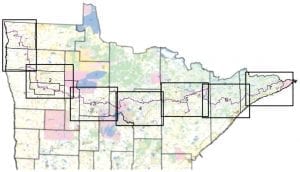Most of the people in attendance at the Border to Border (B2B) informational meeting held this past week voiced peaceful opposition to the route that is proposed to start in Cook County and meander its way on low maintenance back roads to the border of North Dakota. The B2B route planning isn’t close to being finished, with changes certain to come and more public involvement, said Mary Straka, who is heading this project up for the DNR.

Tuesday evening, June 19, the Cook County commissioner’s room was packed with people interested in learning more about the proposed 400-mile off-road vehicle (OHV) Border-to-Border (B2B) route.
Leading the meeting was Mary Straka, Minnesota DNR, Parks, and Trails Division. Accompanying Straka was Kevin Johnson, a DNR area assistant supervisor from Two Harbors and Judy Ness, a volunteer who is helping with the planning. Ness said she retired after 37 years employment with the Forest Service.
The proposal, as it stands now, said Straka– adding that this is still very much in the planning stages—is to form a maze of roads that will connect the eastern and western borders of Minnesota across the northern third of the state using minimum maintenance and rugged roadways.
The end product will be a signed, mapped route for highway-licensed, largely four-wheel drive vehicles, following roads “that minimize asphalt” added Straka, and are already open for driving.

The seven squares and the line running through them mark the proposed border-to-border Off Road Vehicles (ORV) route. It is being touted as a scenic driving route. Opponents of the route favor that instead the DNR work on building alternative low impact OHV closed loop parks like the one in Gilbert, Minnesota.
Spur roads that connect riders to lodging, restaurants, camping, fuel, will be provided through signage and will help boost the local economies these OHV travelers pass through, Straka said.
However, many in the room expressed concern about increased traffic on these quiet roads, possible invasive species being carried from North Dakota to Cook County by OHV vehicles, stream and water degradation, noise pollution, and cost of road repair and added law enforcement.
In 2015, the Minnesota Legislature authorized funding through a gas tax from off-road vehicles and registration fees, with the money put into the off-road vehicle account in Minnesota’s Natural Resources Fund. Revenues for this fund come from registered off-road vehicle owners, said Straka.
The current plan depicts a network of back roads that will start in Horseshoe Bay in Hovland and run through Cook, Lake, St. Louis, Itasca, Beltrami, Clearwater, Polk, Red Lake, Pennington, Marshall, and Kittson county to the North Dakota border to form the B2B route.
The Minnesota Department of Natural Resources Parks and Trails Division, in conjunction with the National Off-Highway Vehicle Conservation Council, has been working with the Minnesota 4-Wheel Drive Association, to plan the B2B.
A series of listening sessions with the public, county boards, and townships was held across the 11 northern counties affected by the Border-to-Border (B2B) Touring Route in 2017, noted Straka, with feedback from those meetings was used to modify and update the plan.
Who is the trail for?
Staka ran through a litany of rules and regulations that will govern the B2B route.
The route is open to anyone who drives a vehicle that is licensed through the Department of Public Safety, Driver, and Motor Vehicle Services.
Vehicles must meet state and federal requirements and meet Department of Transportation standards for road use, including thresholds for overall noise emissions.
It is not planned for Allterrain vehicles, but if a road is now open to ATVs, it will still be legal to ride ATVs on that road.
All roads selected for the B2B trail that are now open to bicyclists, truck drivers, horseback riders, runners, walkers, etc., will remain open for those users, said Straka, with common courtesies, responsibilities, and cautions followed by the motorized users taking the route.
The route will be open at the time spring road restrictions are lifted until November 1, Straka said, adding that those times will be advertised on the DNR website.
Working with local authorities, the DNR will post signs marking the route. However, said Kevin Johnson, the DNR has been adding much technology to its services, and the B2B route might be able to be accessed online as people travel it, which could cut down on signs.
Proponents for and against
A local group in favor of the B2B route in Cook County has gathered 350 signatures with a new goal of gathering 400 signatures that will be delivered to the Cook County Board of Commissioners.
Brad Thompson, who spoke at the Tuesday night meeting in favor of the B2B trail, mentioned that the local ATVs and OHV users gave up the Pincushion trail site so hikers, bikers and cross-country skiers could use it. “There’s room enough here for everybody,” he said. “I see this as a low impact route, not an off-road trail as the opposition is trying to make this out. It is a leaflooker and wildlife-viewing route. We all have the right to travel across our country.”
However, plenty of people in the room were in opposition, and Straka faced many tough questions.
Denny Fitzpatrick asked, in light of an already tight maintenance budget for forest roads, who would maintain U.S. Forest Service roads in case they were damaged by more substantial than regular use. Straka replied that there would be a fund for maintenance that the Forest Service could access.
Sharon Frykman said she counted over 40 access points to water or wetlands along the route touted for Cook County. “It only takes one person to trash one trout stream,” noted Frykman, who added that Cook County does not have enough law enforcement to patrol the B2B trail to stop this type of potential degradation.
“It is frightening to think what could happen in the blink of an eye,” said Straka, who explained this type of thing could happen even without the B2B designation.
Maryl Skinner asked about Ron Potter’s statements concerning the second phase of the B2B.
Potter is a retired DNR employee who is a consultant for the National Off-Highway Vehicle Conservation Council. He has driven the route and offered suggestions for changes.
In an article published in the Minnesota Public Radio webpages, Potter talked about a second phase to the B2B route which will include a plan “to build several challenge loops off the trail to attract serious off-road aficionados,” but noted that that would not happen for several years.
At this point there is no plan for a second phase on the B2B route, Straka said in reply to Skinner.
Another audience member asked if any county had opposed the trail coming through their county. Straka replied affirmatively that Clearwater County had passed a resolution asking for the route to skip by the county.
Part of that resolution states: “Whereas, Department of Natural Resources spokesperson Mary Straka, stated they were looking for a scenic adventure trail. She further emphasized the ideal route would be rugged, unpaved, low maintenance roads with obstacles like roots, trees, rocks, to encourage slower speed,
“And whereas, enforcing the legal and responsible use of public roadways by Off-Highway Vehicles may not be possible through the resources available to County Government. Self-policing is unlikely to be successful because of the nature of the B2B trail activities and whereas, the additional cost for road maintenance and repair would be significant for Clearwater County, and while there is proposed provisions for repairs, it seems doubtful that Clearwater County would be made whole.
“Now therefore it be resolved, that Clearwater County is opposed to the Border to Border Trail, because of potential cost this trail could have on the taxpayers of Clearwater County due to the repairing of roads, cost of public safety and therefore we respectfully request that the portion of the B2B trail drafted for Clearwater County be abandoned or rerouted.”
Straka said the B2B route through Clearwater County might be done on paved roads, but she added that she would meet with them again to discuss this resolution in further detail.
More comments echoed at the Tuesday meeting from those opposed to the B2B route can be found on a petition page that was delivered to the Cook County commissioners. This page had 106 signatures on it on June 20 with a new goal of reaching 200.
“Hiking, biking, canoeing, and skiing leave little imprint and allow time to be in tune and in spirit with our pristine forests. Whereas, “mudding” simply destroys, pollutes, disturbs wildlife and fills a desire that has nothing to do with appreciating the wilderness. Please consider an alternative and save our forests from this threat,” wrote Bonnie Fairchild from Grand Marais.
John Bragstad, Grand Marais, wrote, “I am absolutely in support of the petition. I do not see a legislative mandate to develop this plan! The town has had no opportunity to vote on this. Land degradation is one thing, noise pollution is another. What we have here is exceptional…”
Straka said off-road vehicle clubs from around the state have agreed to help care for the trail, and grant-in-aid funds may be available to help local units of county government as well.
If the B2B route passes muster, it will be marketed on the DNR website, said Straka.
There are similar successful OHV trails in southern Oregon and northern California, she noted.
Before anything happens, any part of the trail planned will undergo public and environmental review along with any necessary permitting before it is on the ground. Which means, said Straka, there is a year or two of work ahead of the DNR to get this project off of the ground.
“We’re working at the speed of government,” she said as the audience broke into laughter. She welcomes more comments for the B2B. They can be sent to mary.straka@state.mn.us.


Loading Comments